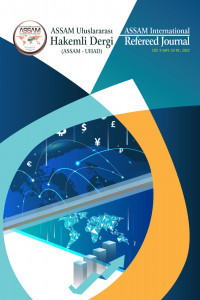ÇİN VE JAPONYA’NIN ÜRÜN BAZINDA İHRACAT YOĞUNLAŞMALARININ ANALİZİ
Günümüzde gerek gelişmekte olan ülkeler gerekse gelişmiş ülkeler ihracat rekabet güçlerini yükseltmeyi ve daha güçlü bir küresel aktör olmayı amaçlamaktadır. Bu bağlamda, ülkelerin rekabet avantajı sağlamaları açısından en önemli anahtar ihracatın ve ihracattaki ürün çeşitlendirmelerinin yükseltilmesidir. Bu perspektifte, bu çalışmada, ihracat yoğunlaşmaları kullanılarak Çin'in ve Japonya'nın ihracat rekabet gücünün karşılaştırmalı bir şekilde analiz edilmesi amaçlanmıştır. 2000-2020 döneminin incelendiği bu analizde yoğunlaşma endekslerinden Yoğunlaşma Oranı (CR) ve Herfindahl-Hirchman Endeksi (HHI) kullanılmıştır. Elde edilen sonuçlara göre, Japonya ile kıyaslandığında Çin’in ürün bazında ihracat yoğunlaşmaları azalmıştır. Diğer ifadeyle, Çin’in ihracatındaki ürün çeşitlendirmesi ve rekabet gücü artmıştır.
Anahtar Kelimeler:
İhracat Yoğunlaşması, CR, HHI, Çin, Japonya
ANALYSIS OF EXPORT CONCENTRATIONS OF CHINA AND JAPAN ON PRODUCT BASIS
Nowadays, both developing countries and developed countries aim to increase their export competitiveness and become a stronger global actor. In this context, the most important key for countries to gain a competitive advantage is to increase exports and product diversification in exports. In this perspective, in this study, it is aimed to analyze the export competitiveness of China and Japan in a comparative way using export concentrations. In this analysis, which examines the 2000-2020 period, the Concentration Ratio (CR) and Herfindahl-Hirchman Index (HHI), which are concentration indices, are used. According to the results, when compared to Japan, China's export concentrations on product basis decreased. In other words, product diversification and competitiveness in China's exports have increased.
Keywords:
Export Concentration, CR, HHI, China, Japan,
___
- Daniel Workman. (2021). World’s Top Export Countries: https://www.worldstopexports.com/worlds-top-export-countries/
- Erkan, B. (2014). Product and Market Diversification in Turkey’s Foreign Trade. International Journal of Advances in Management and Economics, 3(1), 1-15.
- Erkan, B. (2019). China as a Global Power in the Face of Developed Countries such as The US, The EU, Germany and Japan: An Analysis in the Perspective of Concentration. Global and Regional Powers- Relations, Problems and Issues in the 21st Century (s. 73-87). içinde Berlin: Peter Lang.
- Kozáková, M., & Barteková, M. K. (2020). Analysis of market concentration in creative industry. SHS Web of Conferences, 83, 1-8.
- Makonnen, T. (2012). Determinants of Export Commodity Concentration and Trade Dynamics in Ethiopia. Addis Ababa: Ethiopian Economics Association/Ethiopian Economics Policy Research Institute (EEA/EEPRI).
- Meilak, C. (2008). Measuring Export Concentration: The Implications for Small States. Bank of Valetta Review, 37, 35-48.
- Statistics Canada. (2017, December 11). Exportdiversification. Component of Statistics Canada: www.statcan.gc.ca/daily-quotidien/171211/dq171211b-eng.pdf
- Tegene, A. (1990). Commodity Concentration and Export Earnings Instability: Evidence from African Countries. The American Economist, 34(2), 55-59.
- World Bank: https://data.worldbank.org/indicator/NE.EXP.GNFS.CD (2021).
- https://www.worldstopexports.com/worlds-top-export-countries/(2021).
- https://wits.worldbank.org/WITS/WITS/Restricted/Login.aspx. (2021).
- ISSN: 2148-5879
- Yayın Aralığı: Yılda 2 Sayı
- Başlangıç: 2014
- Yayıncı: Adaleti Savunanlar Stratejik Araştırmalar Merkezi Derneği
Sayıdaki Diğer Makaleler
TÜRKİYE’DE PARA ARZI İLE ENFLASYON ARASINDAKİ EŞBÜTÜNLEŞME İLİŞKİSİNİN ANALİZİ
ÖZEL GÜVENLİK HİZMETLERİ: HİNDİSTAN ÖRNEĞİ
TÜRK YÖNETSEL REFORMLARININ BAŞARISINA ETKİ EDEN FAKTÖRLER
DEĞİŞEN KAMU GÜVENLİĞİ ANLAYIŞI VE YENİ NESİL SAVAŞ
SAĞLIK ÇALIŞANLARININ PSİKOLOJİK SÖZLEŞME DÜZEYİNİN ÖRGÜTSEL MUHALEFET İLE İLİŞKİSİ
YEREL YÖNETİM OMBUDSMANLIĞI SİSTEMİ: TÜRKİYE’YE UYGULANABİLİRLİĞİ
Türkiye’de Yeni Bir Hükümet Sistemi: Cumhurbaşkanlığı Hükümet Sistemi
Elvettin AKMAN, Onur KULAÇ, Aizat CHİFTCHİ
RUMLARIN AKRİTAS SOYKIRIM PLANLARI VE KIBRIS'TA ÇÖZÜMSÜZLÜĞÜN BAŞLANGICI
21. YÜZYIL DÜNYA DÜZENİ’NİN ARAÇLARI: KOVID-19 VE YAPAY ZEKÂ
